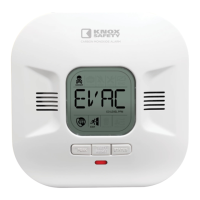This CO alarm is intended for residential use. It is not intended for industrial
applications where Occupational Safety and Health Administration (OSHA)
requirements for carbon monoxide alarms must be met. This device is not
intended to alert hearing impaired residents. CO alarms are not yet available
for the hearing impaired.
CO alarms may not wake all individuals.
Practice an escape plan at least twice a year, ensuring that everyone is
involved, from kids to grandparents. Allow children to master fire escape
planning and practice before holding a fire drill at night when they are
sleeping. If children or others do not readily awaken to the sound of the CO
alarm, or if there are infants or family members with mobility limitations,
make sure that someone is assigned to assist them in the event of an
emergency. It is recommended that you hold a fire drill while family members
are sleeping to determine in their response to the sound of the CO alarm
while sleeping and decide whether or not they may need assistance in
the event of an emergency.
CAUTION! This CO alarm will not sense CO that does not reach its sensor.
It will only sense CO at the sensor. CO may be present in other areas. Doors
or other obstructions may affect the rate at which CO reaches the sensors. If
bedroom doors are usually closed at night, we recommend installing a CO
alarm in each bedroom and in the hallway between them.
This CO alarm may not sense CO on another level of the home.
Example: This alarm device, installed on the second floor, may not sense CO
in the basement.For this reason, one alarm device may not give adequate
early warning.
CO alarms may not be heard.
The alarm horn loudness meets or exceeds current UL standards of 85 dB at
10 feet (3 meters). However, if the CO alarm is installed outside the bedroom,
it may not wake up a sound sleeper or one who has recently used drugs or
has been drinking alcoholic beverages. This is especially true if the door is
closed or only partly open. Even persons who are awake may not hear the
alarm horn if the sound is blocked by distance or closed doors. Noise from
traffic, stereo, radio, television, air conditioner, or other appliances may also
prevent alert persons from hearing the alarm horn. This CO alarm is not
intended for people who are hearing impaired.
This CO alarm is not a substitute for life insurance. Though this CO alarm
warns against increasing CO levels, Knox Safety, Inc. does not warrant or
imply in any way that they will protect lives. Homeowners and renters must
still insure their lives.
This CO alarm has a limited life.
Although this CO alarm and all its parts have passed many stringent tests
and are designed to be as reliable as possible, any of these parts could fail at
any time. Therefore, you must test this device weekly. The unit should be
replaced immediately if it is not operating correctly.
This CO alarm is not foolproof.
Like all other electronic devices, this CO alarm has limitations. It can only
detect CO that reaches the sensors. It may not give early warning of the
source of CO in a remote part of the home, away from the alarm device.
Individuals with medical problems may consider using warning devices
which provide audible and visual signals for carbon mon-oxide
concentrations under 30 PPM.
GENERAL LIMITATIONS OF CO ALARMS
17

